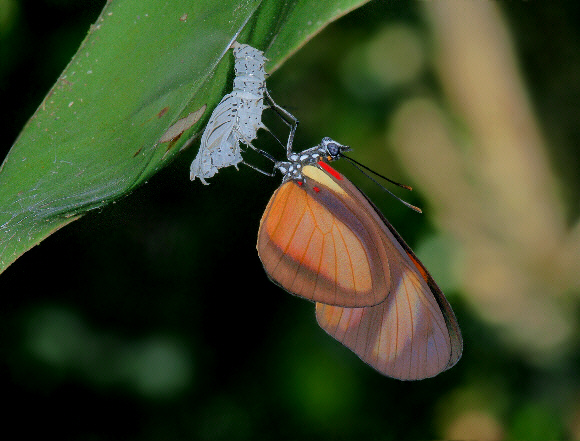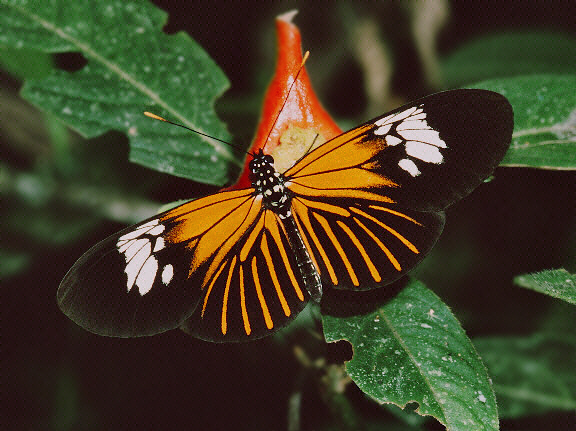Emergence
Emergence of the adult butterfly or moth from the pupa is triggered by factors including humidity, temperature, light level and time of day. Most butterflies emerge shortly after dawn.
The spiracles of the butterfly within the pupa are linked by short tubes to the spiracle openings on the pupa shell. Just prior to emergence air is drawn in through these tubes, enabling the butterfly to pump up its body, which causes the shell of the pupa to split, just behind the head.
The butterfly then forces its way out, using its legs to pull itself clear of the empty pupal shell. If the pupa was formed within a silken shelter, as is the case with most Hesperiidae species, the butterfly first ejects solvents from the proboscis. These soften the silk enough to allow it to push its way out.

Having emerged and settled into position, the insect then spends several minutes hanging virtually motionless. During this time it pumps fluids into the wing veins, causing the wings to expand to their full size. After drying the wings, and before taking their first flight, butterflies and moths expel the metabolic waste product meconium from their abdomens, in the form of a pinkish liquid. Male butterflies usually fly off as soon as their wings are hardened, but females of many species tend to stay within a few metres of the emergence site until mated.
Sex ratios
It is often claimed that more male butterflies emerge than females. The most quoted example is of Rajah Brooke’s Birdwing Trogonoptera brookiana whose males are sometimes stated to outnumber females by a ratio of as much as 10:1. These claims however are caused by sampling inadequacies – females of most species are more secretive in behaviour, better camouflaged, and tend to spend most of their lives in habitats that are less accessible to observers, e.g. in the forest canopy.
Males on the other hand tend to be more colourful and are considerably more visible in their behaviour, e.g. males of brookiana and many other species habitually aggregate in large numbers to imbibe moisture from muddy ground. Captive breeding experiments with brookiana and hundreds of other species have proven that both sexes actually emerge in similar numbers.
In most species males emerge at least a day or two before females. The explanation usually given for this is that females usually mate on the day they emerge, so it is advantageous if there are already plenty of males available to them. Another factor not usually mentioned in literature is that males of some species are not capable of mating until they are 2-3 days old.
This is because they need to feed in order to accumulate alkaloids that are vital to reproduction. Well known examples of this include the Purple Emperor whose males feed at dung, Swordtails and Daggerwings which feed at urine, and Glasswings such as Pteronymia sao which feed on decomposing plant material. The latter derive pyrrolizidine alkaloids from the plants, which are used in the production of pheromones and defensive toxins, as well as for reproductive purposes.
Feeding behaviour
Males of many tropical species are regularly observed imbibing dissolved minerals from damp mud, bird droppings, aphid secretions, sap runs, or even from carrion. The minerals are later passed to the females during copulation, and may contain vital nutrients necessary for the production of fertile eggs.
In temperate regions both sexes of most species feed primarily at nectar, but males of several species, e.g. Apatura iris, Lysandra coridon, Pyrgus alveus, Thymelicus lineola and Mellicta athalia commonly imbibe mineralised moisture, or visit dung.
Certain members of the subfamily Heliconiinae are unusual in that their females use nectar to dissolve pollen which they collect from rainforest flowers. Studies by Gilbert of captive Heliconius ethilla in Trinidad have shown that females deprived of pollen only lay about 15% of the number of eggs laid by females that have access to pollen.
The pollen provides nutrients that cannot be sequestered from other sources, and contributes greatly to the longevity of the butterflies. They have been recorded as living for up to 8 months as adults – most other tropical species live for only a few days.

Heliconius xanthocles, sequestering pollen from Psychotia ‘hotlips’ flowers – Adrian Hoskins
